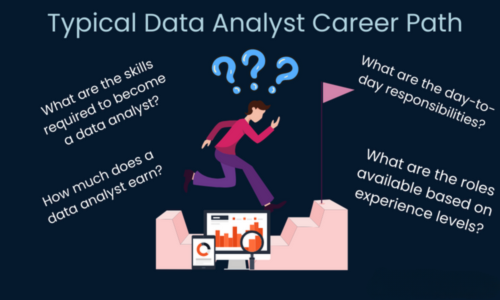Are you looking to start an exciting and rewarding career in data analytics? As businesses generate more data than ever before, the need for data analysts to turn that information into meaningful insights continues to grow rapidly.
This comprehensive guide will walk you through everything you need to launch a successful data analyst career path in 2024 and beyond.
Skyrocketing Demand for Data Analysts
The big data analytics market is expanding at a breakneck pace. Analysts predict it will balloon from a $181 billion industry in 2020 to over $229 billion by 2025.
What does this growth mean? More open jobs for skilled data pros like you!
There are already over 460,000 open data analyst positions just in the US that need to be filled. And that number will only climb higher as companies aim to leverage data to drive smarter decisions.

It’s clear that choosing a data analyst career path will give you no shortage of opportunities now and in the future. But it also comes with some nice perks like an:
- Average Annual Salary of $67,196
- Ability to work in fast-growing and exciting industries like tech, healthcare, finance, etc.
- Endless options to advance your career over time into specialized or management roles
So in short, yes – being a data analyst is a very good career choice!
And in this guide, you’ll get all the tips you need to set yourself up for data analytics success.
What Does a Data Analyst Do?
Before diving into the specifics of getting started, let’s make sure you have a clear understanding of what data analysts actually do day-to-day.
In short, a data analyst gathers, organizes, and analyzes data using various statistical techniques and programming tools. Their goal is to uncover meaningful patterns, trends, and insights that can drive smarter business decisions and strategies.
Some of the daily responsibilities a data analyst can expect include:
- Building databases and data pipelines to manage incoming information
- Mining data from disparate internal and external sources
- Cleaning and processing raw data to prepare it for analysis
- Analyzing datasets using statistical modeling and data visualization to spot trends and make predictions
- Reporting via presentations and dashboards to communicate findings
- Collaborating with data engineers, scientists, and business teams on initiatives
In other words, data analysts are the data wizards who help companies make better data-backed decisions!
6 Steps to Become a Data Analyst
If being a highly-paid data expert appeals to your interests and abilities, then you’re probably wondering – how do I start my data analyst career?
Luckily, with some strategic planning and effort, you can go from data novice to full-fledged analyst. Just follow these 6 key steps:

Let’s explore what’s entailed in each milestone on the road to data analytics success.
Step 1: Develop In-Demand Analytics Skills
The very first thing you need is in-demand skills. Data analyst recruiters and hiring managers look for these 5 must-have abilities:
1. SQL + Database Skills
As most companies store their data in databases, SQL skills are non-negotiable. You’ll use SQL querying to extract the data needed for analysis.
2. Data Visualization
Great data analysts don’t just analyze information – they can also clearly communicate insights using data visualization tools like Tableau.
3. Spreadsheets (MS Excel)
Even in today’s high-tech world, spreadsheets remain ubiquitous on data teams. Brush up on your Excel skills like PivotTables and VBA macros.
4. Programming with Python/R
While not always mandatory, having Python or R programming knowledge gives you a huge leg up over other entry-level analysts. These tools power data cleaning, analysis, and modeling processes.
5. Statistics + Machine Learning
Having at least a basic grasp of key statistical and machine learning concepts will help you become a well-rounded analyst.
Many aspiring analysts make the mistake of just learning programming without focusing on actual data analysis skills. Avoid this pitfall by becoming proficient in ALL five areas above.
Step 2: Understand Data Analyst Roles
Another key preparation step is making sure you understand the day-to-day roles and responsibilities required for the job.
We already covered the essential functions like collecting, cleaning, analyzing, and reporting on data.
Here are a few other common data analyst tasks you can expect:
- Document data sources, metrics, and analysis to help others reproduce reports
- Monitor data quality by double-checking for anomalies
- Train junior data team members to follow best practices
- Research new data tools and analytical approaches to improve insights
Remember – you’ll wear many hats as a data analyst! So be familiar with the diverse set of expectations before applying for jobs.
Step 3: Land an Entry-Level Data Analyst Job
Once you have the baseline skills and knowledge under your belt, it’s time to get that crucial first data analyst job!
Aim for an entry-level or junior analyst role at a company you find interesting. For example, junior analyst positions exist across:
- Tech – Google, Oracle
- Retail/eCommerce – Amazon, Walmart
- Banking – JPMorgan, WellsFargo
- Healthcare – Optum, Kaiser Permanente
Look for junior roles centered specifically on analytics tasks like reporting, visualization, and SQL programming.
You may only qualify if you have:
- Bachelor’s degree
- 1-2 years experience in an analytics or data role from internships or assistant jobs
- Proof of your abilities via a portfolio of analytics projects
But the payoff is that these stepping stone jobs get your foot firmly in the industry door, setting you up for progression.
Step 4: Advance Your Career Over Time
Speaking of career progression – once in an analytics role, you’ll gain the expertise needed to level up into more advanced positions over time.
After 2-5 years as an entry-level analyst, common next steps include promotion to:
- Senior Data Analyst – Lead complex analysis and teams
- Analytics Manager – Manage a data analysis team and oversee enterprise-level reporting
- Data Consultant – Advise clients full-time on optimizing analytics strategies
Each jump will come with significantly higher pay and managerial responsibilities.
And some analysts choose to specialize as they advance by moving into roles like:
- Business Analyst – Analyze operations and strategy
- Financial Analyst – Supply financial insights to guide investments
- Marketing Analyst – Optimize ad campaigns and product launches
The key is continuing to build in-demand skills as you progress. Never stop learning and seizing opportunities to expand your capabilities.
Step 5: Consider Industry-Specific Roles
Beyond private sector companies, data analysts are also needed across public sector organizations in health, government, education, and more.
These industries need tailored analytics experts to make sense of their complex, specialized data.
For example, as a Healthcare Data Analyst, you would turn patient health records, clinical metrics, and hospital operational data into insights that enhance care quality, lower risks, and reduce costs.
Or as a Marketing Data Analyst, you would analyze campaign statistics and audience behaviors to improve marketing ROI and optimize spends.
Every field now leverages data analytics in unique ways – allowing you to align your career with your interests.

Let’s explore some top industry-specific analyst career paths…
Healthcare Data Analyst
Data is transforming how healthcare facilities deliver patient services. By analyzing clinical, health outcomes, and operational data, Healthcare Analysts power decision-making to:
- Enhance treatment quality
- Lower patient health risks
- Reduce costs
- Improve access to care
For example, by studying historical symptoms and biomarker data, analysts build models that allow providers to earlier detect diseases like cancer or diabetes.
Healthcare data analysts have skills like:
- Clinical data analysis
- Statistical modeling – regression, Bayesian statistics
- AI and machine learning – risk modeling, image recognition
- Python, R, SQL, visualization tools
And they tackle responsibilities such as:
- Analyzing patient diagnostic data
- Identifying cost reduction opportunities
- Predicting health outcomes and risks
- Tracking quality care metrics
- Monitoring population health trends
Major health systems like Optum, Kaiser, and CVS Health need a growing army of healthcare data experts to transform care delivery.
Marketing Data Analyst
Today’s data-driven marketing landscape also offers great opportunities to specialize as an analyst.
Marketing analysts use customer data from sources like web traffic, social media, CRM systems, and online ads to optimize ROI. Their analysis guides critical initiatives like:
- Audiences targeting
- Multi-channel campaigns
- Content personalization
- Real-time bid optimization
- And more
Crucial marketing analyst skills include:
- Web/App analytics tools – Google Analytics, Mixpanel
- A/B testing analysis
- Customer segmentation
- Predictive modeling
- Campaign reporting and optimization
And their daily responsibilities involve:
- Tracking campaign KPIs
- Analyzing audience behaviors
- Data mining to discover new opportunities
- Presenting insights on performance
Major brands like Salesforce and Starbucks hire marketing analysts to enhance personalization and grow revenue.
Financial Data Analyst
For number crunchers, financial data analysis is the perfect sweet spot combining finance and analytics.
These analysts use data to guide time-sensitive investment decisions, minimize risk, and capitalize on market opportunities.
You would apply predictive modeling, sentiment analysis, and statistical approaches to data like:
- Stocks and commodities pricing
- Corporate financial statements
- Consumer spending behaviors
- Economic indicators
To supply insights like:
- Investment recommendations
- Market growth forecasts
- Economic impact assessments
- Risk analysis across portfolios
Top skills for financial analysts include:
- Time series analysis
- Statistical modeling – Monte Carlo simulations, regression
- Quantitative modeling – optimization, machine learning
- Financial modeling – discounted cash flows, sensitivity analysis
And standard responsibilities consist of:
- Building financial models, dashboards, and reports
- Data mining to inform investment positions
- Monitoring economic data for trends
- Supplying data-backed guidance to investors
Banks, hedge funds, insurance firms, and more finance domains hunger for data experts to optimize returns.
Step 6: Build an Analytics Portfolio
Last but certainly not least – you need to showcase your blossoming data analyst skills to employers!
Creating an analytics portfolio allows you to demonstrate first-hand experience working with real-world datasets to uncover insights.
Your portfolio might feature case studies highlighting your ability to:
- Mine a database using SQL
- Build regression models in Python to make predictions
- Visualize consumer purchase data patterns in Tableau
- And more!
Sprinkle these tangible analytics deliverables across your:
- LinkedIn profile
- GitHub account
- Personal website
- Job applications
Data-driven companies will be super impressed by self-initiated analytics projects – helping you stand out from the applicant crowd.
Planning Your Data Analyst Career Path
As you can see, launching your data analytics career follows a fairly linear progression – starting from zero experience up to management roles.
Let’s explore some specifics across popular job levels to help tactically map out your data analyst career journey.
Entry-Level Data Analyst
Landing that crucial first full-time data analyst job starts your career off on the right foot.
These roles go by titles like:
- Junior Data Analyst
- Associate Data Analyst
- Assistant Data Analyst
- Data Analyst Trainee
While responsibilities differ across companies, common entry-level analyst tasks look like:
- Gathering, cleaning, and validating data for analysis
- Assisting senior analysts on statistical modeling and visualization tasks
- Creating reports and dashboards under supervision
- Monitoring data quality and integrity
- Improving data collection procedures
Entry-level positions usually require:
- Bachelor’s degree in a quantitative field
- Internship experience in analytics or related roles
- Working SQL, Excel, data visualization skills
- Understanding of basic statistical and modeling techniques
In return for handling the simpler analytical tasks, junior data analysts earn an average annual salary of $46,734 in the United States.
Senior Data Analyst
A few years of experience under your belt allows promotion to the vital Senior Data Analyst role.
As a senior team member, you’ll take the lead designing and executing complex analysis initiatives across your company.
Common responsibilities look like:
- Owning end-to-end advanced analytics projects
- Identifying new opportunities for data to drive business value
- Combining data from disparate sources into consolidated systems
- Building and optimizing machine learning models to improve insights
- Mentoring junior analysts to enhance their skills
You’ll need to exhibit senior-level skills like:
- Mastering advanced applications of SQL, Python, R
- Communicating data insights through compelling visualizations
- Leveraging statistical and quantitative methods for modeling
- Converting analysis findings into actionable business recommendations
In return, senior data analysts command an average salary of $92,495 per year in the United States.
Data Analytics Manager
Further down the road, experienced data analysts may choose to try their hand at people management.
As a Data Analytics Manager, you’ll lead an entire team of data analysts and scientists – coordinating complex data initiatives across the business.
Standard responsibilities look like:
- Setting goals, strategic vision, and priorities for your analytics team
- Fostering Analyst skills development and career growth
- Tracking and optimizing team performance metrics
- Communicating insights to executive leadership
- Managing data platform governance and access
This managerial role requires skills like:
- Team leadership – motivate, provide feedback, resolve conflicts
- Understanding when to apply advanced analytics approaches
- Knowledge of data architecture – systems, governance, security
- Ability to translate technical analyses into business insights
Business leaders value data team leadership – making analytics managers a well-compensated role with an average salary around $84,373.
Data Analytics Consultant
Last but not least, experienced analysts can also move into advisory and client-facing Data Consultant positions.
As a consultant, you’ll leverage your analytics design, engineering, modeling, and strategy skills to:
- Advise clients on achieving data-driven results
- Design analytics platforms, models, and reporting
- Instrument data tracking in apps and websites
- Perform program and product analytics
- Improve personalization with analytics
- Optimize processes using analytics
Essentially you become your clients’ external data analytics expert – helping guide their success.
This high visibility, high impact role requires abilities like:
- Communicating complex data insights to leadership
- Data warehousing and infrastructure architecture
- Cloud analytics – GCP, AWS, Azure
- Pitching the value of analytics initiatives
- Scoping analytics needs for clients
In return, consultants earn fat paychecks averaging $101,350 per year as one of the top-paying analyst career options.
Start Your New Data Analyst Career Today
As you can see, a world of rewarding data analyst career opportunities await in this booming era of big data.
Now is the time to add your skills to a workforce seeing over 25% urgent annual job growth.
With strategic preparation guided by this step-by-step career path and roles overview, your future looks bright.
Whether you aspire to work for a hot tech disruptor fueling innovation – or a stalwart enterprise brand dominating an industry – your data abilities open doors.
So what are you waiting for?
Start mastering the in-demand skills, building the hands-on experiences, and creating the compelling portfolio to land that dream career.
The overflowing demand for data analysts means you get to choose your adventure in this exciting new frontier of technology.
Now get out there, have fun, and launch what could become a life-changing data analytics journey!
Good luck!







